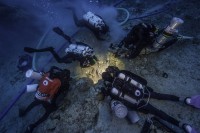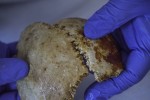 Archaeologists diving the site of the Antikythera shipwreck in the Aegean Sea have discovered human skeletal remains. The Return to Antikythera team, which has been exploring the site since 2012, found the bones under a foot and a half of pottery fragments and sand on August 31st. They recovered the cranium, a partial jawbone with three teeth, ribs, the long bones of the arms and legs and some other pieces. The rest of the skeletal remains are still embedded in the sea floor.
Archaeologists diving the site of the Antikythera shipwreck in the Aegean Sea have discovered human skeletal remains. The Return to Antikythera team, which has been exploring the site since 2012, found the bones under a foot and a half of pottery fragments and sand on August 31st. They recovered the cranium, a partial jawbone with three teeth, ribs, the long bones of the arms and legs and some other pieces. The rest of the skeletal remains are still embedded in the sea floor.
This isn’t the first time human remains have been found at the Antikythera wreck site. Famed marine explorer Jacques Cousteau found a smattering of bones during his two-day survey of the site in 1976. Osteoarchaeological analysis concluded that those bones were the remains of at least four people, although only three individuals could be identified: a young man, an adult woman and a teenager of undetermined sex. Having been treated for conservation purposes and exposed to a variety of temperature and environmental conditions, those bones can no longer be tested for DNA, not that they were ever prime candidates for recovery of ancient DNA.
 That was a long time ago, aeons in terms of scientific technology, and this latest find isn’t just a bone here or there scattered by currents and marine life. This is the undisturbed skeleton of one person whose remains appear to have been protected by a thick debris layer, and it is the first ancient skeleton to be recovered from a shipwreck since the dawn of DNA analysis. Researchers are excited at the prospect of being able to extract a testable DNA sample from the bones, something that has never been attempted on an ancient shipwreck victim, to find out more about a crew member or passenger of the ancient merchant vessel laden with luxury objects that sank in around 65 B.C.
That was a long time ago, aeons in terms of scientific technology, and this latest find isn’t just a bone here or there scattered by currents and marine life. This is the undisturbed skeleton of one person whose remains appear to have been protected by a thick debris layer, and it is the first ancient skeleton to be recovered from a shipwreck since the dawn of DNA analysis. Researchers are excited at the prospect of being able to extract a testable DNA sample from the bones, something that has never been attempted on an ancient shipwreck victim, to find out more about a crew member or passenger of the ancient merchant vessel laden with luxury objects that sank in around 65 B.C.
Within days of the find, [Woods Hole Oceanographic Institution archaeologist and co-director of the excavations team Brendan] Foley invited [Hannes] Schroeder, an expert in ancient-DNA analysis from the Natural History Museum of Denmark in Copenhagen, to assess whether genetic material might be extracted from the bones. On his way to Antikythera, Schroeder was doubtful. But as he removes the bones from their bags he is pleasantly surprised. The material is a little chalky, but overall looks well preserved. “It doesn’t look like bone that’s 2,000 years old,” he says. Then, sifting through several large pieces of skull, he finds both petrous bones — dense nuggets behind the ear that preserve DNA better than other parts of the skeleton or the teeth. “It’s amazing you guys found that,” Schroeder says. “If there’s any DNA, then from what we know, it’ll be there.”
Schroeder agrees to go ahead with DNA extraction when permission is granted by the Greek authorities. It would take about a week to find out whether the sample contains any DNA, he says: then perhaps a couple of months to sequence it and analyse the results.[…]
Schroeder guesses from the skeleton’s fairly robust femur and unworn teeth that the individual was a young man. As well as confirming the person’s gender, DNA from the Antikythera bones could provide information about characteristics from hair and eye colour to ancestry and geographic origin.
The video captures the moment of discovery and the divers’ unbridled joy.
[youtube=https://youtu.be/6pF0Ie4YvEo&w=430]
The Return to Antikythera team 3D scan every artifact they discover so that scholars all over the world can examine their finds. Here is a 3D model of the bones in situ.
[youtube=https://youtu.be/afSYf8v-XK0&w=430]
Here are the femurs recovered from the sea floor and in the laboratory.
[youtube=https://youtu.be/c4KFRNkbUaQ&w=430]